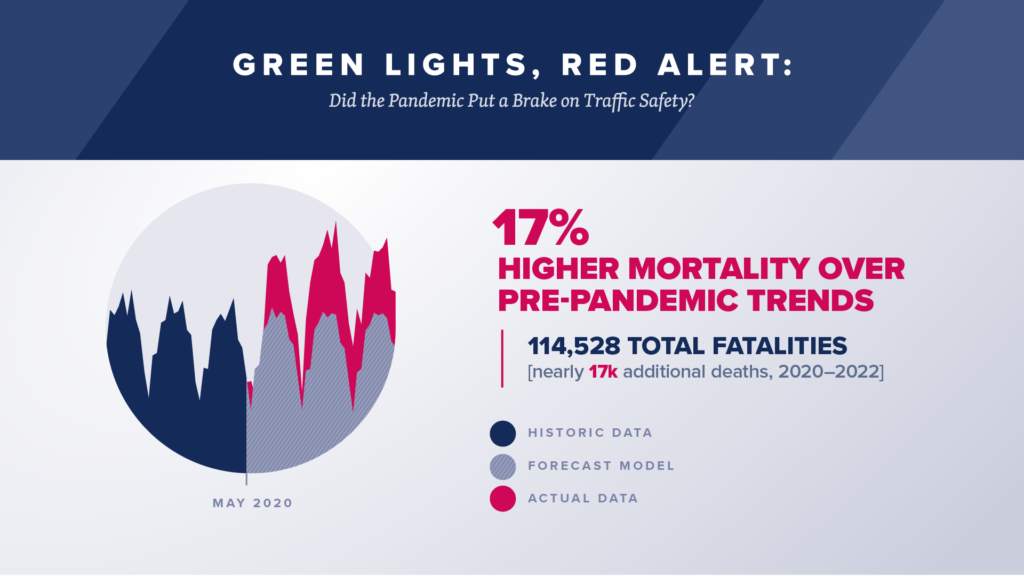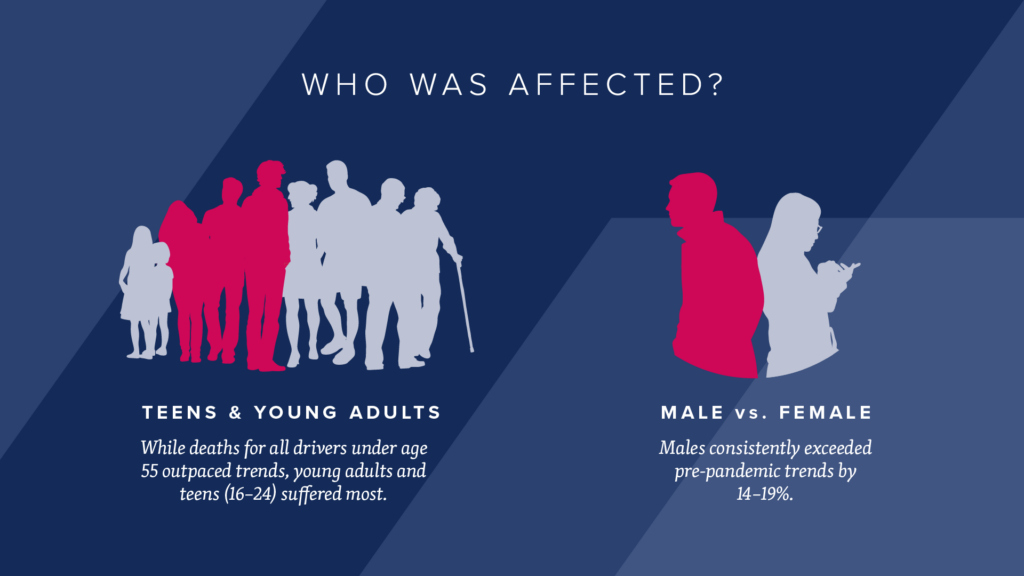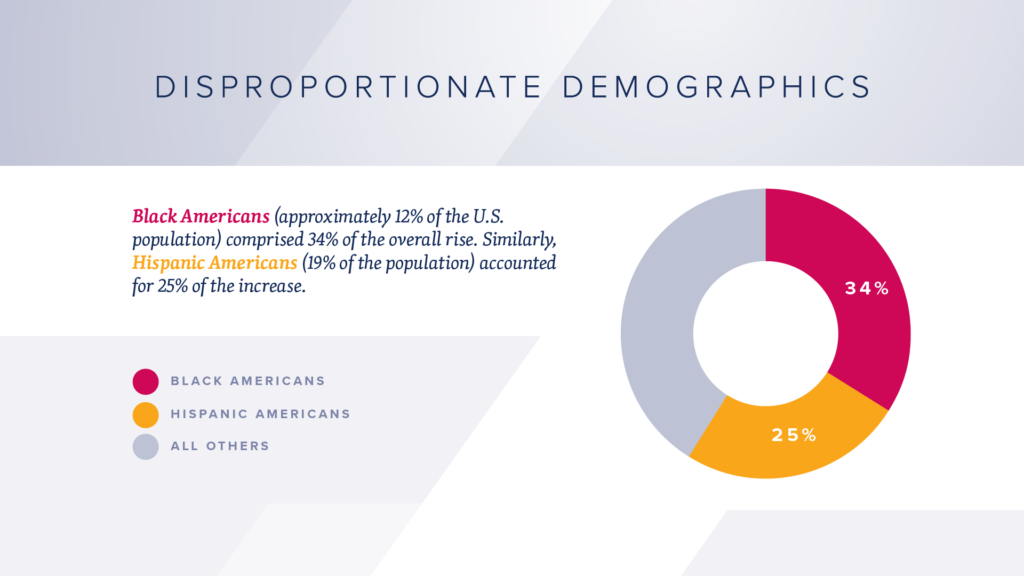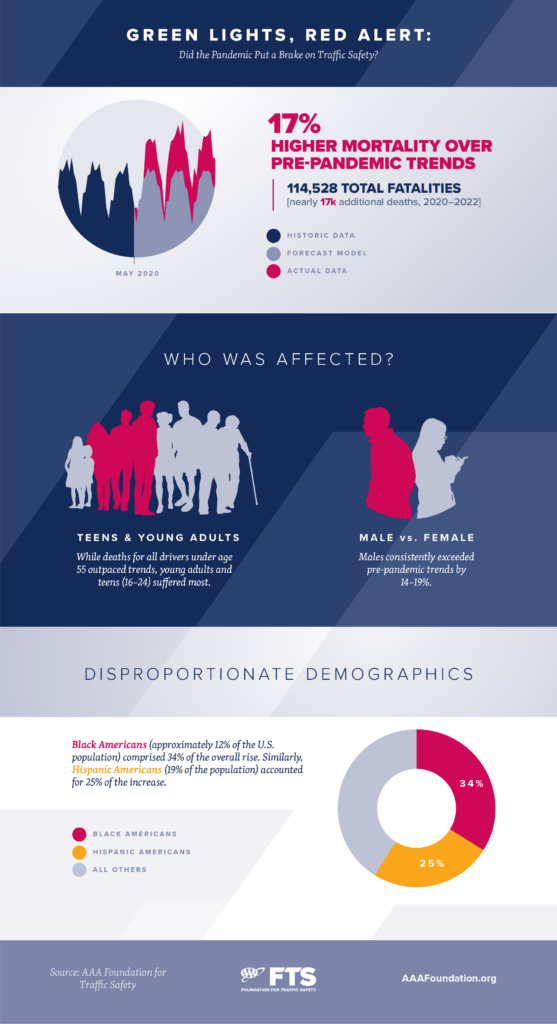PORTLAND, Ore., – – A new study by the AAA Foundation for Traffic Safety reveals the COVID-19 pandemic has left a lasting deadly impact on traffic safety in the U.S. Researchers at the AAA Foundation found dangerous behaviors such as speeding, not using seatbelts, and impaired driving contributed to a significant rise in fatal crashes compared to the years before the pandemic.
AAAFTS researchers found that 114,528 people were killed in traffic crashes on U.S. roads from May 2020 through December 2022, a 17% jump in traffic deaths (nearly 17,000 additional fatalities) compared to what would have been expected under pre-pandemic trends:
- Traffic deaths outpaced forecasts the most for young adults (20-24), with teens (16-19) taking the top spot in 2021.
- Men consistently exceeded estimates by 14% to 19%, while women only did so in 2021 (15% increase).
- Black Americans, who comprise approximately 12% of the U.S. population, accounted for approximately 34% of the entire rise in traffic fatalities relative to how many would have been expected based on the pre-pandemic trend.
- Hispanic Americans, 19% of the U.S. population, accounted for approximately 25% of the increase.
- Adults 25 years and older with no education beyond high school exceeded estimates by 12% to 16%.
Notably, the new research highlights a disparity in the pandemic’s impact on traffic safety. Black and Hispanic Americans, already disproportionately affected by traffic fatalities, saw even more significant increases from 2020 through 2022. Similarly, those with less education experienced a much sharper rise in fatalities compared to college graduates.
Here is the research brief.



“Our study points to an ongoing disturbing trend of risky driving behaviors, which we noted in previous research earlier in the pandemic,” said Dr. David Yang, president and executive director of the AAA Foundation. “There are still far too many road users who lose their lives in preventable crashes. The findings from this latest AAA Foundation study underscore the importance of addressing traffic safety from an equity perspective – communities across the United States must provide safe transportation options to meet the needs of their users.”
Here are key findings in the study:
- Risky driving spiked: Speeding and driving under the influence of alcohol remain significant contributors to fatal crashes.
- Lack of seatbelt use: The increase in occupant deaths was almost entirely among those not wearing seatbelts.
- Fatal crashes across age groups: Drivers and victims of all ages up to 55 saw a significant rise in fatal crash involvement, with men disproportionately affected.
- Late-night danger zone: Contrary to initial assumptions, the increase in fatal crashes wasn’t limited to times when the pandemic cleared previously congested daytime roads. Late nights and early mornings saw the most significant spikes.
- Unequal impact: The pandemic exacerbated existing disparities in traffic safety. Socially and economically disadvantaged counties and racial and ethnic minorities were disproportionately impacted.
The research underscores the need for:
- Equitable transportation solutions: Providing safe transportation options for vulnerable populations benefits everyone.
- Holistic safety approaches: Addressing broader traffic safety issues beyond just the pandemic’s effects.
- Safe System framework offers a comprehensive strategy to improve overall road safety.
“Our AAA Foundation research shows that the COVID-19 pandemic has had a lasting negative impact on traffic safety in the U.S., with impaired driving, speeding, and not wearing a seat belt all contributing to a surge in crash fatalities. These behaviors continue long after the pandemic ended,” says Marie Dodds, public affairs director for AAA Oregon/Idaho. “We have a lot of work to do to provide equitable access to safe transportation for all if we truly have the goal of reducing fatal crashes.”

Research methodology
The research reported here seeks to understand how traffic safety on U.S. roads has changed since the onset of the pandemic by comparing the number and characteristics of traffic fatalities during this period to what would have been expected if the pandemic had not occurred and pre-pandemic trends continued. Data from the fatal crashes in the decade before the pandemic were used to develop statistical models that were then used to predict how many fatal crashes would have been expected during the pandemic period, without the pandemic.
About the AAA Foundation for Traffic Safety
Established in 1947 by AAA, the Foundation for Traffic Safety is a nonprofit, publicly funded 501(c)(3) charitable research and educational organization. The AAA Foundation’s mission is to prevent traffic deaths and injuries by researching their causes and by educating the public about strategies to prevent crashes and reduce injuries when they do occur. This research informs the development of educational materials for drivers, pedestrians, bicyclists, and other road users.
AAA news releases, high resolution images, broadcast-quality video, fact sheets and podcasts are available on the AAA NewsRoom at NewsRoom.AAA.com.
Find local news releases at https://oregon.aaa.com/community/media/media-contacts.html
For more info go www.AAA.com. AAA Oregon/Idaho provides more than 900,000 members with travel, insurance, financial and automotive-related services, and is an affiliate of AAA National, serving more than 64 million motorists in North America.

